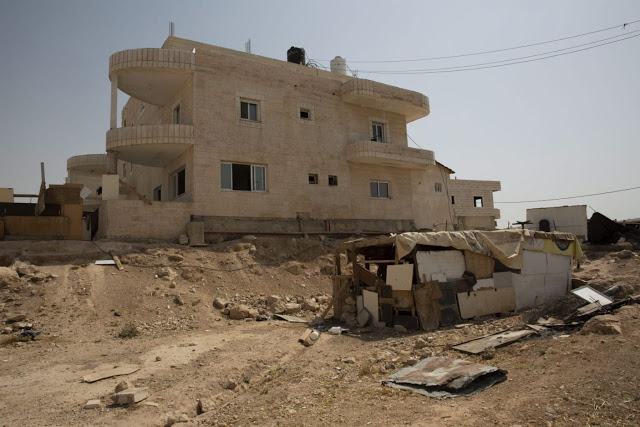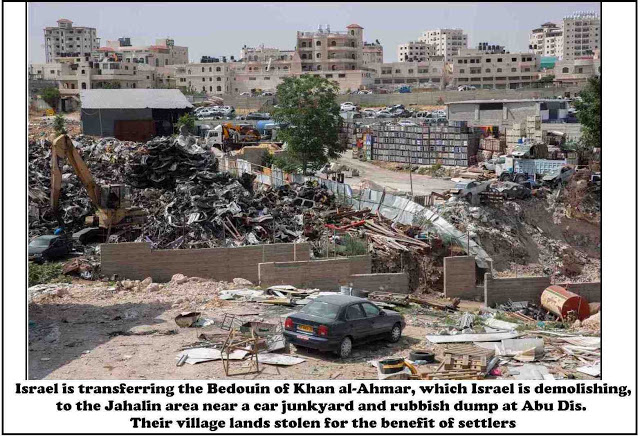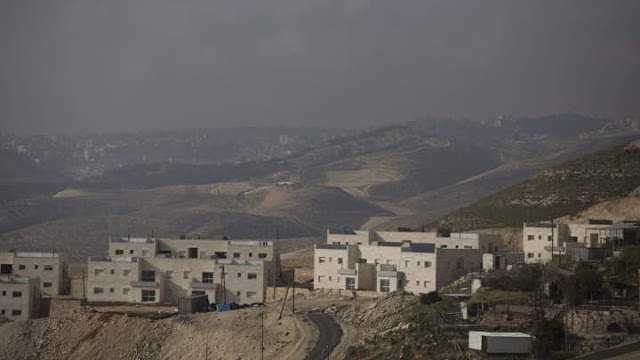Like Apartheid
South Africa before it, Israel is moving Palestinians into bleak and
desolate townships
Ma’ale Adumim, a city of nearly 40,000 settlers which is 4 miles from Jerusalem
and Kfar Adumim. About 200 people live
there with a school that is attended by about 150 children in the area. The aim
of the eviction is to create a continuous belt of settlements from Jerusalem into
the West Bank, at the same time dividing the West Bank in two.
expelled from the Negev in 1952 by the Israeli army. They moved the following
year to the West Bank. In the late 1970s the villagers found themselves
incorporated into lands that were assigned to what became the Maale Adumim
settlement. The village is one of the only remaining Palestinian areas within
the E1 zone, strategically significant because it connects the north and south
of the West Bank.
harassment and attacks by the Israeli army and the settlers. In 2015, solar
panels were donated to provide the village with electricity. In July, the Civil
Administration confiscated the solar panels, as well as one which had been in
the village for several years.[1]
Palestinians don’t require electricity under Israel’s colonial regime.
 Children in the Bedouin village of Khan al-Ahmar, West Bank, May 15, 2017.
Children in the Bedouin village of Khan al-Ahmar, West Bank, May 15, 2017.
unanimously that starting from June, the Israeli army could move the village to
a different location and carry out the demolition and eviction of the Palestinian
village of Khan al-Ahmar.[2]
Justices Noam Solberg, Yael Willner and Anat Baron approved expelling the
population and razing their homes.
who is himself a resident of an illegal Israeli settlement, Alon Shvut in the
Gush Etzion bloc. Sohlberg wrote that the grounds for the decision rejecting a
villagers’ petition for a stay in the order, was that the residents had
unlawfully engaged in building both the school and housing, and that it was not
within the court’s remit to meddle in the execution of Israeli state laws.
illegal is because Israel’s colonial administration refused to issue permits to
Palestinians for such things as schools and housing. The Supreme Court however was not interested
in asking why permits are not granted to Palestinians because that might come
perilously close to examining the legitimacy of the Occupation itself. A
colonial court such as Israel’s Supreme Court can only concern itself with
procedural questions. Of course Israeli
settlements aren’t troubled by such legal niceties since the granting of
permits and master plans for their development is taken for granted.
 Abu Ali Abu Ghalia at the projects committee for a Jahalin Bedouin neighborhourhood
Abu Ali Abu Ghalia at the projects committee for a Jahalin Bedouin neighborhourhood
location since before the settlement of Kfar Adumim was established. Despite
this, the state refused to include them in the master plans it prepared for the
settlers. Consequently, the buildings that the justices deemed illegal were all
built without permits.
that the Occupation, which is in conflict with International Law is nonetheless
legal under Israeli law. The role of the
Court is to put a legal gloss on the Occupation. Whenever there is a conflict between Israeli
Law and International Law the former prevails.[3]
As Hagai El-Ad, Director the Israeli Human Rights NGO B’tselem noted:
decades, the Supreme Court justices have granted legitimacy to practically any
injustice that Israel wishes to cause to the Palestinians: demolishing their
homes, administrative arrests, revoking residency rights, seizing land,
constraining their movement. Still, it isn’t every day that six of the 15
Supreme Court justices sign off on rulings on the fate of Palestinian subjects
that boil down to approving crimes.[4]
that Israel had failed to connect the township to water, power and sewerage
services, and that the villagers had built without permits because Israeli policy
is such that is dissuades Palestinian villagers from even trying to obtain
licenses to build, a claim also repeated by Human Rights Watch. The effect of the dismantlement
and evictions will be, he added, to bisect the West Bank from north to south. [5]
 |
| Thousands of settlers in Kfar Etzion celebrating celebrating 50 years of settlement September 27, 2017. (Gershon Elinson FLASH90) |
requirements of the law, but whether carrying out the demolition orders meets
the requirements of the law.” The “inarguable
point of departure” was that the buildings in question were “illegal.”
something that the Court was concerned about. It noted that “the village school doesn’t have a yard that
meets standards.” It didn’t even meet “acoustic
standards”! In normal circumstances one might expect that
a court of law would order that the owners install sound proofing or build a
yard of sufficient size. However that
would be to entirely miss the point. This is Israel and these are
Palestinians. The only solution that the
Court was prepared to agree to was to demolish and expel.
 The Bedouin village of Khan al-Ahmar, West Bank, May 15, 2017.
The Bedouin village of Khan al-Ahmar, West Bank, May 15, 2017.
al-Ahmar is going to be demolished and its inhabitants expelled the Civil
Administration (run by the Military) is set to approve the construction of 92 building
in Kfar Adumim, a settlement less than a mile away from Khan al-Ahmar.[6]
acres) which in turn is part of a larger plan, comprising 322 new homes on 660
dunams, which passed the first stage of its approval process in February 2017.
The new neighborhood will be called Nofei Bereishit.
the World Zionist Organization Settlement Division. The Jewish Labour Movement, which as we all
know is terribly concerned about ‘anti-Semitism’, is affiliated to the WZO.[7]
So although the JLM is formally a supporter of a 2 States solution, they are
affiliated to a body that is responsible for providing funds to build
settlements designed to prevent that solution! Such is the hypocrisy of Labour Zionism.
a brother and sister who live in Kfar Adumim. Nevertheless, she didn’t offer to
recuse herself from hearing the case. Willner, Sohlberg and Baron subsequently
rejected a request by attorney, Shlomo Lecker, that she do so.
they didn’t give them building permits, it turns out that the Israeli
government has no problem with issuing permits for this land – just not to
Palestinians.”
 Girls going to school in the Bedouin village of Khan al-Ahmar,
Girls going to school in the Bedouin village of Khan al-Ahmar,
intends to evacuate the residents of Khan al Ahmar to the village of Al Jabel,
an area near the Abu Dis garbage dump that the state has allocated for the
permanent settlement of the Jahalin Bedouin, refugees
from the Negev who have lived in the area since before 1967. It has already become a slum and the
shepherds will have to give up their flocks, with the consequent increase in
unemployment. The status of women will also be adversely affected.[8]
heap, which also serves Ma’aleh Adumim, brings throngs of flies and mice to the
neighborhood, conveying the Israeli authorities’ contempt. The sewage holes
frequently overflow. This is one of the residents’ main grievances: If they
already prepared the land for construction, why didn’t they build a sewage
system?
‘90s, Israel expelled around 150 families from about 10 Bedouin communities,
including Salaila’s, to the new site. The Bedouin’s expulsion for a “permanent settlement,” now known as
al-Jabal (the mountain), was carried out in three phases. Now the High Court of
Justice has let the state expel to that site a fourth wave of Bedouin
families from Khan al-Ahmar. It’s locked between the largest
garbage dump in the West Bank to the east, and the Al-Eizariya car junkyard to
the west. [9]
Salaila spoke passionately about the women’s committee she set up two years ago
that meets regularly in a large container that houses old furniture, a modest
kitchenette and an old ventilator to alleviate the heat a bit.
a few other local women run all the activities, which consist of courses for
women, project-management training, and games and tutoring for children. Amir
Hass described how three women joined the conversation with Salaila: the twins
Amani and Iman Abu Ghalia, 22, and their cousin, Hind Abu Ghalia, 27. “Men are not part of this,” Salaila said,
with unconcealed pride.
four women, all university graduates hoping to continue their studies, refused
to have their faces photographed. While assertive and aware of their duty to
advance the status of women in their community, they nonetheless partially
submit to what Salaila calls “the shame
culture,” part of which is their families’ – especially the men’s –
objection to having pictures of women published.
 Palestinian girls watch TV at their home on May 30, 2018 in Khan al-Ahmar village. MENAHEM KAHANA AFP
Palestinian girls watch TV at their home on May 30, 2018 in Khan al-Ahmar village. MENAHEM KAHANA AFP
around the neighborhood at midday revealed a strange phenomenon: no women are
in sight. Is it the heat? No. Even the four women we talked to in the container
wouldn’t join our stroll but went straight to their homes next door.
like that,” one of them said. “Once we used to stroll outside the neighborhood a little.”
from the Defense Ministry’s Civil Administration have flattened a few lots, on
which the forced evacuees are supposed to build their own houses. The new plots
are very near one another, a tight cluster of houses and families alien to the
Bedouin’s way of life.
Jahalin neighborhood there is no room for flocks of sheep. “We buy milk. Imagine that – Bedouin buying milk!” says Hind Abu
Ghalia. She has lived in the neighborhood most of her life but feels the
absurdity of this reality.
time. In the past they took part in the work. Economically, a man couldn’t make
it without his wife. Today the woman is only at home with no work
opportunities,” Salaila says.
doesn’t let his wife go out. If she hasn’t studied, she’s even more captive in
her own house. Once, when we lived in the encampment, women also met and talked
to each other. That custom has been lost.”
 Plots leased to the Bedouin at al-Jabal in the West Bank
Plots leased to the Bedouin at al-Jabal in the West Bank
now have electricity, running water, and shelter from nature’s hazards. But
deprived of the chance to work for a living, they’ve lost the reason to move
around.
women told researchers from the group Bimkom, who last year wrote a report
about the expulsion’s negative effect on women at al-Jabal and Arab
al-Rashayida southeast of Bethlehem.[10]
When there’s no choice but to leave home, they wear a niqab, a face covering
that wasn’t customary when they lived in the open. Twenty years after the
forced relocation, most of them have suffered damaged self-esteem.
neighborhood got its water from Israel water company Mekorot, allowing for a
regular water supply. Then the locals were linked to the Al-Eizariya
municipality. Israel limits the water supply to the Palestinians, so in the hot
months they don’t have running water every day.
living, some families have split. Some of their members look after the flocks
and still live outdoors in tents. Some make a living off jobs in nearby
settlements. But according to a member of the neighborhood’s projects
committee, Abu Ali Abu Ghalia, unemployment among the men is very high.
basic conditions must be kept when you move from a life of herding to an urban
environment. A water and electricity infrastructure isn’t enough. You have to
give the people training to change their profession so we can live in the new
conditions. A man can’t turn overnight from a shepherd into a driver or a
teacher,” he adds.
there are planned at 300 square meters (3,229 square feet) per family, less
than what was allocated for the previous waves of expellees. No pasture land
has been allotted.
response to Lecker’s petition against the demolition at Khan al-Ahmar, the
state said that at the beginning of June it would finish building a school that
will replace the ecological school. The new school would accommodate 150
students.
Administration employees accompanied by policemen entered Khan al-Ahmar to take
measurements. It would appear that the
demolition and evictions are imminent. [11]
Ahmad Abu Dahuk, a village resident, told Haaretz that the Civil Administration
representatives, accompanied by security personnel, were seen five times at the
entrance to the village, on Route 1, which leads to Jericho. The sixth time, he
said, on Sunday around noon, they entered the village, walked around the
houses, entered the ecological school (the well-known one made of tires, which
is also slated for demolition), and counted the flocks of sheep. He said the
children who were in the school fled in panic.
told B’Tselem that a police officer told them they would be evacuated by force
and that they would be better off leaving “willingly.”
also told Haaretz that “We are afraid to
sleep, in case they come at night and destroy our homes, and we are afraid when
we wake up, in case they come then to destroy them.”.
High Court paved the way for the demolition last month, police, army and Civil
Administration representatives have been coming to the site periodically to
survey the area and the houses to determine the best points of entry for the
heavy vehicles and bulldozers. This time, however, the surveying raised
concerns that the demolition and eviction were imminent. No doubt Sohlberg,
Baron and Willner will sleep easily in their beds.
Israel’s ethnic cleansing of the Palestinians continues apace. After having concentrated the Bedouin in the
new township the next phase will be transfer from the country altogether.
Greenstein
[1] See
Khan al-Ahmar, https://en.wikipedia.org/wiki/Khan_al-Ahmar.
[2] Israel
to Demolish Entire West Bank Bedouin Village, Ending Year-long Legal Battle ,
Amira Hass, Ha’aretz 25.5.18. https://www.haaretz.com/israel-news/.premium-israel-to-demolish-entire-west-bank-bedouin-village-1.6116488
[3] See
Israel’s Supreme Court: Liberal bastion or an enforcer of injustice?, Ben
White, Middle East Eye, 23.3.18., http://www.middleeasteye.net/columns/how-israel-s-supreme-court-reinforces-discriminatory-status-quo-1678693361
[4] Khan
al-Ahmar and Gaza: Two Sides of the Same Legal Coin, Ha’aretz, 5th
June 2018, https://www.haaretz.com/opinion/khan-al-ahmar-and-gaza-two-sides-of-the-same-legal-coin-1.6152008
[6] Israel
to Build 92 New Settlement Homes Near Bedouin Village Slated for Demolition,
Amira Hass, Ha’aretz, 30.5.18., https://www.haaretz.com/israel-news/.premium-israel-to-build-92-homes-in-settlement-near-condemned-bedouin-village-1.6132947
[7] About
the Jewish Labour Movement, http://www.jlm.org.uk/about
[8] Israel’s
Solution for Expelled Bedouin: Between the Garbage Dump and Junkyard, Ha’aretz,
11.6.18., Amir Hass, https://www.haaretz.com/israel-news/.premium.MAGAZINE-israel-s-solution-for-expelled-bedouin-between-garbage-and-junkyard-1.6158225
[9] Israel
to Demolish Entire West Bank Bedouin Village, Ending Year-long Legal Battle,
Amira Hass, Ha’aretz 25.6.18., https://www.haaretz.com/israel-news/.premium-israel-to-demolish-entire-west-bank-bedouin-village-1.6116488
Bimkom, http://bimkom.org/wp-content/uploads/The-effect-of-forced-transfer-on-Bedouin-women-Eng_DESIGN1.pdf




